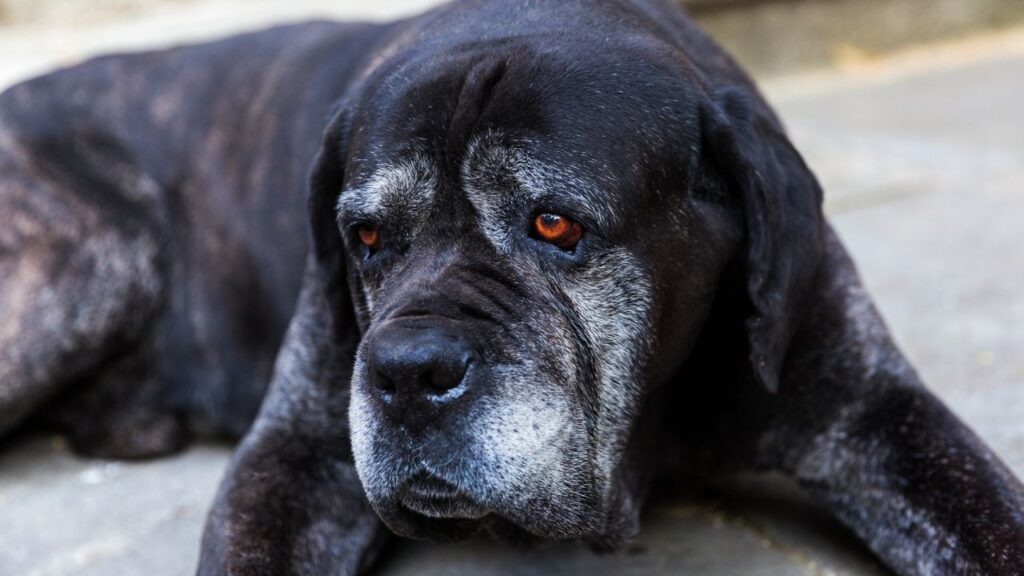Many squamous cell carcinomas in dogs can be completely surgically removed if caught early – and that could be curative.
Key Takeaways
- Squamous cells cover internal and external surfaces in the body. They are found in the skin, corneas, blood vessels, body cavities, and digestive, respiratory, urinary, and reproductive tracts. Treatments and prognosis depend upon the location of the tumor.
- If left untreated, squamous cell carcinoma can metastasize. Every case is different, but prompt treatment is important.
- Dogs with squamous cell carcinoma have a median survival time of 1004 days (almost three years).
- Dogs with toe squamous cell carcinoma who underwent amputation had a 1-year survival rate of 76.2% and a 2-year survival rate of 42.9%.
- Dogs with tonsillar squamous cell carcinoma have various prognoses.
- Squamous cell carcinoma is the most common skin cancer in dogs and the most common cancer capable of metastasis.
- While aggressive, dogs with squamous cell carcinoma can live well during treatment and have a good quality of life.
- Symptoms of squamous cell carcinoma vary based on location and may include redness, swelling, ulceration (a sore that won’t heal), or a lump.
What Squamous Cell Carcinomas Are, and Where They Occur
Squamous cell carcinomas (often abbreviated to SCC) in dogs can occur just about anywhere squamous cells are found — and squamous cells are found nearly everywhere in the body.
Squamous cells are flattened plate-like epithelial cells. They look a little bit like fish scales. As epithelial cells, they cover the internal and external surfaces of the body. The term “carcinoma” means cancer of epithelial cells.
Eyes, Blood Vessels, and Cavities
Squamous cells are found in the skin and corneas (the clear covering of the eye), the lining of blood vessels and body cavities, and the lining of the digestive, respiratory, lower urinary, and reproductive tracts.
Spread and Metastasis
Most squamous cell carcinomas are solitary lesions, but rarely, this cancer can be multicentric (occurring in two or more sites).
Some types can metastasize (spread) to other areas of the body, most commonly the lymph nodes and the lungs.
Some squamous cell carcinomas may metastasize if left untreated, while others are locally invasive.
Stats and Facts about Squamous Cell Carcinoma
- Squamous cell carcinoma is the most common cancer that is capable of metastasis.1
- It is also the most common skin cancer in dogs.
- Fortunately, cutaneous or dermal (skin) squamous cell carcinoma tends to have a low metastatic rate, meaning it is not common for it to spread to other areas of the body.
- However, cutaneous squamous cell carcinoma that occurs on the digits (toes) is especially aggressive, often causing destruction of the bones in the toes.
- Digital or subungual (under the toenail) squamous cell carcinoma affects front feet more often than rear feet.2
- When Giant Schnauzers or Standard Poodles develop subungual squamous cell carcinoma, the risk of developing new, additional subungual tumors (on different toes or different feet) within two to three years after the first occurrence is 56%; the risk of local recurrence (tumor regrowth after successful surgical removal) and metastasis is 4%.3
- Squamous cell carcinoma is the second most common oral malignant tumor in dogs.
- Oral squamous cell carcinoma is divided into two subtypes: tonsillar (on the tonsils) and nontonsillar (all locations in and around the mouth except for the tonsils).
- The tonsillar form is the less common of the two but is highly metastatic
- The nontonsillar form comprises 50-78% of all oral squamous cell carcinoma tumors and is the most common tumor of the tongue.
- Nontonsillar squamous cell carcinoma has a low incidence of metastasis.4
Squamous Cell Carcinoma Causes
Cancer of any kind is never caused by “just one thing.” It is a multifactorial disease, and many things must go wrong for cancer to take root. That said, ultraviolet exposure (sunlight) has been implicated as a cause of cutaneous squamous cell carcinoma.5
Although papillomavirus is a risk factor for squamous cell carcinoma in humans, that has not been demonstrated in dogs.6

Risk Factors for Squamous Cell Carcinoma
The following is what we know about things that put dogs at increased risk for developing squamous cell carcinoma. Remember that these are only risk factors; not every dog with these characteristics develops squamous cell carcinoma.
- Overall, breeds most often affected by squamous cell carcinoma include Scottish Terriers, Pekingese, Poodles, and Norwegian Elkhounds.
- Dark-haired dogs, especially large breeds like Labrador Retrievers and Rottweilers, are often affected by digital or subungual squamous cell carcinoma, and their tumors are generally more aggressive than when light-haired dogs develop similar masses.7
- Dogs with light, sparse hair, like Dalmatians, Whippets, white Bull Terriers, and Beagles, are prone to sunlight-induced cutaneous squamous cell carcinoma because they have less fur-provided skin protection from the sun.
- Dogs with chronic inflammatory eye conditions are often treated with long-term topical immunosuppressives like cyclosporine or tacrolimus. While very helpful for treating those eye problems, immunosuppressive medications may increase their risk of developing corneal squamous cell carcinoma later.8
Squamous Cell Carcinoma Symptoms
Symptoms of squamous cell carcinoma vary widely because these tumors can occur in many locations.
Skin Squamous Cell Carcinoma Symptoms
Skin squamous cell carcinoma, also called dermal or cutaneous squamous cell carcinoma, can occur anywhere on the skin. A frequent site for skin squamous cell carcinoma is the nasal planum, the bridge of the nose. Skin lesions are often red, irritated, ulcerated, or crusty. There may be a raised nodule or lump.
Toe Squamous Cell Carcinoma Symptoms
Toe squamous cell carcinoma, also called digital (toe) or subungual (under the nail or nailbed) squamous cell carcinoma, can be a source of significant pain. Dogs with squamous cell carcinoma in their toe may limp or lick excessively at the toe. The toe is typically swollen, and sometimes the most noticeable evidence of this swelling is that the direction the toenail “points” deviates from the other nails on that foot. The digit may be red, ulcerated (have an open sore), or bleeding. The bleeding might be intermittent or consistent.
Oral Squamous Cell Carcinoma Symptoms
Tumors in the mouth frequently cause drooling (which could be blood-tinged), foul odor from the mouth, and reluctance to eat that results in weight loss, tooth loss, coughing, or difficulty swallowing.
Nasal Squamous Cell Carcinoma Symptoms
When squamous cell carcinoma is in the nasal passages, dogs may exhibit sneezing, nasal discharge, and even facial deformity if the tumor invades the sinuses.
Eye Squamous Cell Carcinoma Symptoms
Corneal squamous cell carcinoma may irritate the eye. A mass may also be visible on the surface of the eye.
How Squamous Cell Carcinoma Is Diagnosed
Once you have brought your dog in for any of the symptoms above, or if a mass is found during a routine examination, diagnosis helps identify squamous cell carcinoma.
Diagnosis of squamous cell carcinoma is made by finding squamous cells exhibiting characteristics of malignancy. Squamous cell carcinoma can be seen under a microscope, so getting a histopathology report done (a description of the tumor sample) is how you get a diagnosis. To get a sample of the tumor, veterinarians will use one or two methods:
- Fine needle aspirates sometimes yield a sample adequate for diagnosis, but not always. If the sample is inconclusive, you might need a biopsy to get the answer.
- Biopsy with histopathology is definitive.
Excisional Biopsy
Sometimes a veterinarian will do what’s called an excisional biopsy. This is commonly called “trying to get it all out.” The surgery attempts to remove the entire mass so that it can be biopsied, and, hopefully, treated.
Incisional Biopsy
Other times, an incisional biopsy is done if the mass is large, invasive, or in a location where it is difficult to remove the entire tumor. This is when the tumor is incised, or cut into, and a small piece of the tumor is submitted for diagnostic purposes only.
Once the biopsy or histopathology report comes back, you will find out the prognosis and stage of squamous cell carcinoma cancer you are facing.
Lauren Ebbecke has an amazing true tail about squamous cell carcinoma and she shares it on DOG CANCER ANSWERS.
Prognosis and Staging for Squamous Cell Carcinoma
The prognosis and expected survival time for a dog with squamous cell carcinoma varies depending on where the tumor is located and how/if it is treated. You will find some of this information on your pathology report; some might come from your oncologist or veterinarian.
Remember that the following numbers are statistics, and the median survival times quoted here do not apply to any individual dog. The median survival time is the “50/50” number in a study. It’s the length of time when half of the dogs had passed away, and half were still alive. Do not assume the numbers below are “how long your dog has to live.”
Squamous Cell Carcinoma Prognosis
For dogs with cutaneous (on the skin) squamous cell carcinoma, the median survival time, irrespective of treatment type, is 1004 days (almost three years).6
Dogs with subungual or digital squamous cell carcinoma who underwent amputation of the affected digit had a 1-year survival rate of 76.2% and a 2-year survival rate of 42.9%. 9
Dogs with tonsillar squamous cell carcinoma have various prognoses.
- One study of dogs with tonsillar squamous cell carcinoma showed an overall median survival time of 243 days.
- In dogs with only one tonsil involved and no evidence of metastasis, the median survival time was 637 days.
- If local metastasis to regional lymph nodes was evident, the median survival time dropped to 134 days.
- If distant metastasis (usually to the lungs) occurred, survival time further decreased to 75 days.
- For dogs who underwent both surgery and chemotherapy, the median survival time increased to 464 days. 10
A study of dogs affected with nontonsillar oral squamous cell carcinoma demonstrated a 1-year survival rate of 93.5% for dogs undergoing curative-intent surgery vs 0% for dogs receiving no surgery treatment.11
Dogs with juvenile-onset oral squamous cell carcinoma (younger than 24 months at the diagnosis) have an excellent prognosis after surgical resection of their tumors. In the study that followed these dogs, none died of squamous cell carcinoma, and some were followed for more than ten years! 12
Squamous Cell Carcinoma Staging
Staging tumors helps you make decisions about what treatments to pursue. It is most important for dogs with squamous cell carcinoma tumor types prone to metastasis, mainly digital/subungual and oral tumors.
The following tests are commonly recommended for staging squamous cell carcinoma:
- Chest radiographs (X-rays) to look for metastasis to the lungs
- Bloodwork, including a CBC and chemistry panel, to assess overall health
- Urinalysis to assess overall health
Dogs with any squamous cell carcinoma that may have to go under anesthesia (for surgery, for example) should also get these tests to assess their anesthesia risks.
Staging can get quite expensive, so this is an area where you can weigh the pros and cons.
- The pros of staging are that you and your dog’s veterinary team will have a complete picture of your dog’s health. You will also know what parts of his body the cancer affects. This information can give you a more accurate idea of how he might do during treatment. You might also be able to rule in or rule out some treatment options.
- The cons are that tests are expensive. The information you get might not change what you decide to do. If you have limited funds, skipping testing so you can allocate your money for treatment is a reasonable choice to make.
Treatment for Squamous Cell Carcinoma
In general, cancer treatment goals for dogs are not about getting a “cure.” Instead, the focus is on maintaining and improving quality of life while hopefully extending life beyond what would happen if cancer wasn’t treated.
Surgery is usually the best option for squamous cell carcinoma of all types.
Surgery for Squamous Cell Carcinoma
Surgery, whenever possible, has been shown to be the most effective treatment for squamous cell carcinoma, no matter where it is in the body.
Early treatment is best because the tumor is likely smaller and easier to remove, and it is less likely to have spread locally or to distant sites. If surgical removal is delayed, it’s more likely to continue to grow, invade local tissues, and/or metastasize.
There are some special surgical considerations for specific squamous cell carcinoma locations.
Bridge of the Nose
In dogs with squamous cell carcinoma on the nasal planum (bridge of the nose), surgery produced better outcomes than radiotherapy alone or radiation in conjunction with surgery.13
Toe Tumors
In cases of digital or subungual squamous cell carcinoma, it is difficult to remove only the tumor itself because the bones of the toes are so very close to most tumors. Removing only the tumor might result in cancer cells being left behind, which are more likely to cause recurrence or regrowth.
That’s why amputation is often recommended for dogs with tumors in these locations. Amputation of the toe provides a more complete removal of cancer cells. And while it may sound extreme, amputation is a more functional and comfortable outcome for the dog. (They quickly recover and walk easily, and with much less pain than before the amputation.)
A study of 79 dogs with this type of squamous cell carcinoma showed that amputation was often curative and suggested that chemotherapy is perhaps only helpful if metastasis has already occurred at the time of surgery. 14
Chemotherapy
Squamous cell carcinoma is not as responsive to systemic chemotherapy as some other types of cancer, but there are cases where it might be considered.
If surgery is impossible because of the tumor location, your veterinarian or oncologist might recommend chemotherapy. In one study, 5 of 9 dogs with oral squamous cell carcinoma who received chemotherapy had tumor remission.15
Depending on your dog’s case, you might be offered a few other chemotherapy options.
Electrochemotherapy, when electric pulses are used to “open” cancer cell walls so they are more permeable and more chemotherapy can get inside, was shown to shrink tumor size and reduce the tumor growth rate in dogs with cutaneous (skin) squamous cell carcinoma.16 Electrotherapy induced complete remission in a few dogs with small nontonsillar oral squamous cell carcinoma tumors.17
Cyclooxygenase-2 (COX-2), an enzyme involved in inflammation, has been found in elevated levels in squamous cell cancers, so COX-2 inhibitors might be part of a treatment plan. While we usually don’t think of drugs like piroxicam or meloxicam (among others) as chemotherapy agents, technically, any chemical used to treat an illness is called chemotherapy.18
Topical chemotherapeutics may be an option for corneal (eye) squamous cell carcinoma lesions, and possibly some cutaneous (skin) lesions.
Radiation for Squamous Cell Carcinoma
Radiation is often considered a secondary treatment, helpful when a tumor cannot be fully surgically removed. This might be the case in dogs with especially large or inaccessible tumors. Radiation may also be considered when surgical removal leaves some cancer cells behind.
Radiation could be a first-line treatment for some oral tumors. In one study in dogs with a subtype of oral (mouth) squamous cell carcinoma (papillary squamous cell carcinoma), nine of 10 dogs treated with radiation therapy alone achieved complete remission19
Photodynamic Therapy for Squamous Cell Carcinoma
Photodynamic therapy might also be offered. In photodynamic therapy, a photosensitizing drug is given. It is nontoxic unless activated by light. Then, it is activated by a specific light wavelength to kill cancer cells. In one study, eight of 11 dogs with oral squamous cell carcinoma treated with this modality were tumor-free for 17 months following treatment.20
Immunotherapy for Squamous Cell Carcinoma
Immunotherapy is not widely used in dogs with squamous cell carcinoma yet, but research in this area is ongoing based on the immunotherapy treatment of human patients with squamous cell carcinoma.21
Vaccine for Squamous Cell Carcinoma
There is no vaccine for dogs, but currently, researchers are pursuing a vaccine for people with head and neck squamous cell carcinoma.22 Because dogs and humans are pretty alike in treating cancer, perhaps future advances in human medicine could also benefit dogs.
Diet Considerations for Squamous Cell Carcinoma
Occasionally, dogs with squamous cell carcinoma may need special interventions to enable them to be adequately nourished. Particularly for dogs with oral or nasal tumors, if the tumor itself – or the surgery or radiation used to treat it – interferes with eating, they may temporarily need a feeding tube to bypass the affected area.
The most important thing when feeding a dog with squamous cell carcinoma, as with any dog, is to ensure that her diet is complete and balanced, providing all the nutrients that her body requires. Although there is no official dog cancer diet, there is a lot of information about diet in our diet section.
Supplements for Squamous Cell Carcinoma
Several studies show that natural compounds have activity against oral squamous cell carcinoma cells:
- Artemisinin is an herb that promotes apoptosis in oral squamous cell carcinoma.24 But do not give it to your dog while she is receiving radiation therapy, because artemisinin targets the high iron content of cancer cells, and radiation increases iron in normal, healthy cells. That makes normal, healthy cells more susceptible to destruction by artemisinin, too.
- In one study, Luteolin, a plant flavonoid, killed oral squamous cell carcinoma cells, so it may be a helpful supplement.25
- Another study showed saffron, cinnamon, ginger, and curcumin – each of them alone, but even more so in combination – have activity against oral squamous cell carcinoma.26
- Vitamin C promotes apoptosis and stops the cancer cell cycle in oral squamous cell carcinoma.27
Medicinal mushrooms, like turkey tail, reishi, shiitake, and others, may also play a role in helping your dog’s immune system attack cancer cells.
Always consult your veterinarian before adding a supplement. They will ensure that it is a good fit for your dog and won’t interfere with her other medications or treatments.
There are more articles about supplements that might be supportive in general in our supplement section.
Integrative Therapies
No current proven integrative therapies are available that specifically target squamous cell carcinoma. However, general life quality improvements help dogs feel happier and more relaxed. Massage, training, and exercise may not directly treat cancer but certainly contribute to overall wellness.
Ben Lewis of FidoCure explains their service, including a touching True Tail about a dog with squamous cell carcinoma.
New Research into Squamous Cell Carcinoma Treatments
We will update this article with links to clinical trials studying new cancer treatments for squamous cell carcinoma.
What You Will See in Your Dog at the End of Life in Squamous Cell Carcinoma
The end-stage for locally invasive squamous cell carcinoma tumors occurs when the affected body part cannot function adequately, or pain is not manageable. For example:
- Oral tumors may prevent dogs from eating or swallowing.
- Squamous cell carcinoma of the digits may destroy bone in the toes, making its way up the leg over time. This is very painful and often prevents dogs from bearing weight on that leg, so they can’t move around normally.
- With tumors that spread to distant sites, dogs may be systemically ill: lack of appetite, weight loss, lethargy, vomiting, and/or diarrhea may occur.
- If cancer metastasizes to the lungs, dogs may cough, pant, or have difficulty breathing.
If at any point you are concerned about your dog suffering unnecessarily, it might be time to have an open conversation with your veterinarian about hospice.
Prevention Strategies for Squamous Cell Carcinoma
Using pet-appropriate sunscreen and limiting sun exposure can help prevent some skin squamous cell carcinoma. This is especially recommended for dogs with sparse, light hair coats.
The are no specific prevention strategies for other forms of squamous cell carcinoma.
Depending upon the results of the VACCS trial to find a preventative cancer vaccine for dogs, we may have even more hope on the horizon.
- Yan, W. et al. (2011) Squamous cell carcinoma – similarities and differences among anatomical sites, American journal of cancer research. U.S. National Library of Medicine. Available at: https://pubmed.ncbi.nlm.nih.gov/21938273/ (Accessed: November 16, 2022).
- Belluco S;Brisebard E;Watrelot D;Pillet E;Marchal T;Ponce F; (2013) Digital squamous cell carcinoma in dogs: Epidemiological, histological, and immunohistochemical study, Veterinary pathology. U.S. National Library of Medicine. Available at: https://pubmed.ncbi.nlm.nih.gov/23735617/ (Accessed: November 16, 2022).
- Chiu, O. et al. (2022) Breed predilections and prognosis for subungual squamous cell carcinoma in dogs, The Canadian veterinary journal = La revue veterinaire canadienne. U.S. National Library of Medicine. Available at: https://pubmed.ncbi.nlm.nih.gov/36325409/ (Accessed: November 16, 2022).
- Grier, C.K. and Mayer, M.N. (2007) Radiation therapy of canine nontonsillar squamous cell carcinoma, The Canadian veterinary journal = La revue veterinaire canadienne. U.S. National Library of Medicine. Available at: https://www.ncbi.nlm.nih.gov/pmc/articles/PMC2034434/ (Accessed: November 16, 2022).
- Sabattini S;Savini F;Gallina L;Scagliarini A;Bassi P;Bettini G; (2016) P16 immunostaining of canine squamous cell carcinomas is not associated with papillomaviral DNA, PloS one. U.S. National Library of Medicine. Available at: https://pubmed.ncbi.nlm.nih.gov/27441555/ (Accessed: November 16, 2022).
- Willcox, J.L. et al. (2019) Clinical features and outcome of dermal squamous cell carcinoma in 193 dogs (1987-2017), Veterinary and comparative oncology. U.S. National Library of Medicine. Available at: https://pubmed.ncbi.nlm.nih.gov/30684311/ (Accessed: November 16, 2022).
- Cerezo-Echevarria A;Grassinger JM;Beitzinger C;Klopfleisch R;Aupperle-Lellbach H; (2020) Evaluating the histologic grade of digital squamous cell carcinomas in dogs with dark and light haircoat-a comparative study of the invasive front and tumor cell budding systems, Veterinary sciences. U.S. National Library of Medicine. Available at: https://pubmed.ncbi.nlm.nih.gov/33396709/ (Accessed: November 16, 2022).
- Dreyfus, J., Dubielzig, R.R. and Schobert, C.S. (2011) Superficial corneal squamous cell carcinoma occurring in dogs with chronic keratitis, Veterinary ophthalmology. U.S. National Library of Medicine. Available at: https://pubmed.ncbi.nlm.nih.gov/21521439/ (Accessed: November 16, 2022).
- O’Brien, M.G., Engler, s J. and Berg, J. (1992) Treatment by digital amputation of subungual squamous cell carcinoma in dogs: 21 cases (1987-1988), Journal of the American Veterinary Medical Association. U.S. National Library of Medicine. Available at: https://pubmed.ncbi.nlm.nih.gov/1399782/ (Accessed: November 16, 2022).
- Grant, J. and North, S. (2016) Evaluation of the factors contributing to long-term survival in canine tonsillar squamous cell carcinoma, Australian veterinary journal. U.S. National Library of Medicine. Available at: https://pubmed.ncbi.nlm.nih.gov/27237121/ (Accessed: November 16, 2022).
- Fulton, A.J. et al. (2013) Risk factors associated with survival in dogs with nontonsillar oral squamous cell carcinoma 31 cases (1990–2010), AVMA. American Veterinary Medical Association. Available at: https://avmajournals.avma.org/view/journals/javma/243/5/javma.243.5.696.xml (Accessed: November 16, 2022).
- Sharma, S. et al. (2020) Survival time of juvenile dogs with oral squamous cell carcinoma treated with surgery alone: A veterinary society of surgical oncology retrospective study, Veterinary surgery : VS. U.S. National Library of Medicine. Available at: https://pubmed.ncbi.nlm.nih.gov/33772819/ (Accessed: November 16, 2022).
- Lascelles , B.D. et al. (2000) Squamous cell carcinoma of the nasal planum in 17 dogs, The Veterinary record. U.S. National Library of Medicine. Available at: https://pubmed.ncbi.nlm.nih.gov/11093398/ (Accessed: November 17, 2022).
- Marconato, L. et al. (2021) Clinical features and outcome of 79 dogs with digital squamous cell carcinoma undergoing treatment: A SIONCOV observational study, Frontiers in veterinary science. U.S. National Library of Medicine. Available at: https://pubmed.ncbi.nlm.nih.gov/33996973/ (Accessed: November 17, 2022).
- Boria , P.A. et al. (2004) Evaluation of cisplatin combined with Piroxicam for the treatment of oral malignant melanoma and oral squamous cell carcinoma in dogs, Journal of the American Veterinary Medical Association. U.S. National Library of Medicine. Available at: https://pubmed.ncbi.nlm.nih.gov/14765798/ (Accessed: November 17, 2022).
- Dos Anjos, D.S. et al. (2019) Electrochemotherapy induces tumor regression and decreases the proliferative index in canine cutaneous squamous cell carcinoma, Scientific reports. U.S. National Library of Medicine. Available at: https://pubmed.ncbi.nlm.nih.gov/31676831/ (Accessed: November 17, 2022).
- Simčič , P. et al. (2020) Electrochemotherapy in treatment of canine oral non-tonsillar squamous cell carcinoma. A case series report, Veterinary and comparative oncology. U.S. National Library of Medicine. Available at: https://pubmed.ncbi.nlm.nih.gov/31419028/ (Accessed: November 17, 2022).
- Bardagí, M., Fondevila, D. and Ferrer, L. (2012) Immunohistochemical detection of COX-2 in feline and canine actinic keratoses and cutaneous squamous cell carcinoma, Journal of comparative pathology. U.S. National Library of Medicine. Available at: https://pubmed.ncbi.nlm.nih.gov/21601872/ (Accessed: November 17, 2022).
- van der Steen, F. and Zandvliet, M. (2021) Treatment of canine oral papillary squamous cell carcinoma using definitive-intent radiation as a monotherapy-a case series, Veterinary and comparative oncology. U.S. National Library of Medicine. Available at: https://pubmed.ncbi.nlm.nih.gov/32975025/ (Accessed: November 17, 2022).
- McCaw, D.L. et al. (2000) Treatment of canine oral squamous cell carcinomas with photodynamic therapy, British journal of cancer. U.S. National Library of Medicine. Available at: https://pubmed.ncbi.nlm.nih.gov/10755404/ (Accessed: November 17, 2022).
- Takaishi, Y. et al. (2008) Expression of SART-1 mrna in canine squamous cell carcinomas, The Journal of veterinary medical science. U.S. National Library of Medicine. Available at: https://pubmed.ncbi.nlm.nih.gov/19122400/ (Accessed: November 17, 2022).
- Sun, Z. et al. (2022) Head and neck squamous cell carcinoma: Risk factors, molecular alterations, immunology and peptide vaccines, International journal of peptide research and therapeutics. U.S. National Library of Medicine. Available at: https://pubmed.ncbi.nlm.nih.gov/34903958/ (Accessed: November 17, 2022).
- Saha, K. et al. (2017) Sulforaphane suppresses PRMT5/MEP50 function in epidermal squamous cell carcinoma leading to reduced tumor formation, Carcinogenesis. U.S. National Library of Medicine. Available at: https://www.ncbi.nlm.nih.gov/pmc/articles/PMC5862259 (Accessed: November 17, 2022).
- Yamachika, E., Habte, T. and Oda, D. (2004) Artemisinin: An alternative treatment for oral squamous cell carcinoma, Anticancer research. U.S. National Library of Medicine. Available at: https://pubmed.ncbi.nlm.nih.gov/15330155/ (Accessed: November 17, 2022).
- Tjioe , K.C., Tostes Oliveira, D. and Gavard, J. (2016) Luteolin impacts on the DNA damage pathway in oral squamous cell carcinoma, Nutrition and cancer. U.S. National Library of Medicine. Available at: https://pubmed.ncbi.nlm.nih.gov/27266882/ (Accessed: November 17, 2022).
- Dehghani Nazhvani, A. et al. (2020) Anti-cancer effects of traditional medicinal herbs on oral squamous cell carcinoma, Asian Pacific journal of cancer prevention : APJCP. U.S. National Library of Medicine. Available at: https://www.ncbi.nlm.nih.gov/pmc/articles/PMC7332120/ (Accessed: November 17, 2022).
- Zhou, J. et al. (2020) Vitamin C promotes apoptosis and cell cycle arrest in oral squamous cell carcinoma, Frontiers in oncology. U.S. National Library of Medicine. Available at: https://pubmed.ncbi.nlm.nih.gov/32587830/ (Accessed: November 17, 2022).
Topics
Did You Find This Helpful? Share It with Your Pack!
Use the buttons to share what you learned on social media, download a PDF, print this out, or email it to your veterinarian.









